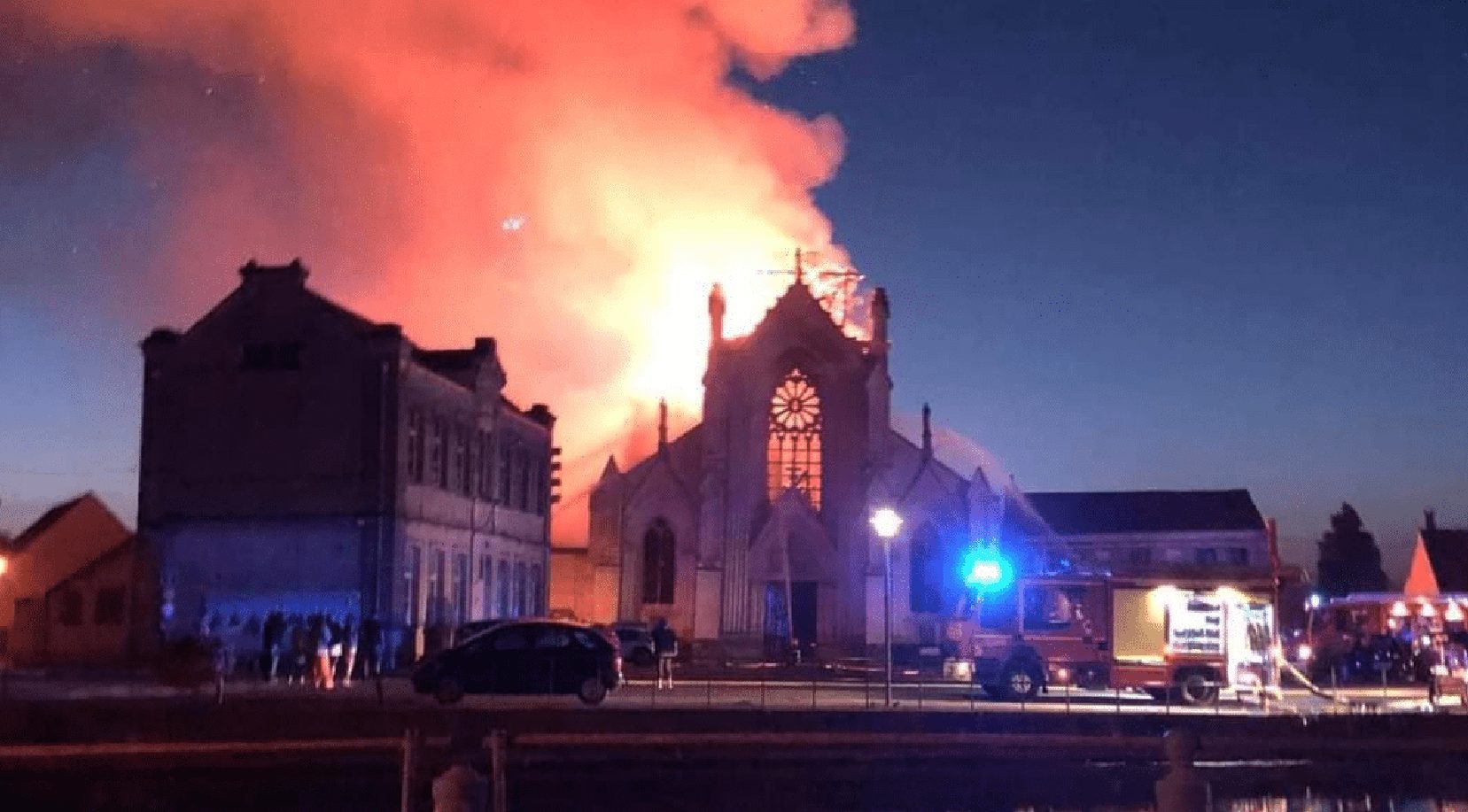(ZENIT News / Paris, 09.05.2024).- In the early hours of September 2, 2024, the town of Saint-Omer in northern France woke to the tragic news of a fire that ravaged the historic Church of the Immaculate Conception. The blaze, which reduced much of the 19th-century neo-Gothic structure to ruins, claimed the iconic bell tower, roof, and the main nave. Although firefighters, numbering 120, managed to contain the fire by 7:15 AM, the damage to the cherished landmark was extensive. Among the losses was the church’s organ, a prized instrument that had become a symbol of the church’s rich musical tradition.
Arson Confirmed as Investigators Find Evidence of Break-In
The fire was not a tragic accident. Early reports from investigators revealed signs of forced entry, pointing to arson as the cause. The flames, which started in the main and side naves, quickly engulfed the entire structure. Despite the severe damage, some of the church’s most precious religious items were salvaged, including the tabernacle and consecrated hosts. Father Sébastien Roussel, the parish priest, was on-site during the inferno and managed to save several important statues, including one of the Virgin Mary, a figure that held deep spiritual significance for the local community.
“My priority was to save the Blessed Sacrament,” Father Roussel shared with local media. Despite his efforts, the church’s recently restored Stations of the Cross, though not removed in time, appeared to have withstood the flames—a small yet poignant victory amidst the destruction.
A Serial Arsonist at the Center of the Tragedy
Authorities wasted no time in identifying a suspect. Joël Vigoureux, a man in his late 30s with a long history of setting fire to Catholic churches, was apprehended shortly after the blaze. Vigoureux had only recently been released from prison after serving time for a series of arson attacks on ten churches across northern France. Since his release, he had resumed his pattern of destruction, making him the prime suspect in the Saint-Omer fire.
Vigoureux’s motivations are rooted in a personal vendetta against the Catholic Church. During his previous trial, he claimed to target churches because he believed that “all priests are pedophiles.” His troubling past, marked by deep-seated resentment and repeated offenses, raises serious concerns about the effectiveness of his judicial supervision and psychological treatment, which clearly failed to prevent further attacks.
A Rising Tide of Anti-Christian Violence in France
The fire at Saint-Omer is the latest in a disturbing trend of anti-Christian attacks across France. According to the Observatory of Religious Heritage, the first half of 2023 saw 12 church fires, many of them confirmed as acts of arson. In total, nearly 1,000 incidents of anti-Christian violence were recorded in 2023, with the vast majority targeting churches and cemeteries.
Incendie de l’église de Saint-Omer: un drone filme l’ampleur des dégâts de l’édifice désormais sans toit pic.twitter.com/0SShypZXTV
— BFMTV (@BFMTV) September 3, 2024
Beyond arson, vandalism and desecration have become alarmingly common. One of the most shocking incidents occurred in July, when Notre-Dame-du-Travail church in Paris was defaced with blasphemous graffiti and threats, with a statue of the Virgin Mary among the items destroyed. These acts of cultural and religious destruction reflect a growing tension between France’s Christian heritage and the increasingly secular and diverse society.
Legal and Social Responses: A Call for Justice
The fire at Saint-Omer has sparked widespread condemnation. The “General Alliance Against Racism and for Respect of French and Christian Identity” (AGRIF) has announced plans to file a lawsuit on behalf of the Catholic community, calling for a stronger response to such acts of hatred. Though the authorities have acknowledged that the Saint-Omer fire was motivated by religious hatred, critics argue that anti-Christian crimes often receive less attention in the media and judicial systems compared to attacks on other religious groups.
Local prosecutor Mehdi Benbouzid has vowed to treat the case as an anti-Christian hate crime, a designation rarely used in French courts. Under French law, religiously motivated crimes can carry harsher penalties, and if convicted, Vigoureux could face a more severe sentence due to the nature of his actions.
The Future of France’s Religious Heritage
The destruction of the Church of the Immaculate Conception raises urgent questions about the future of religious sites in France, a nation where the secularization of society is increasingly at odds with the protection of its Christian heritage. Despite a nationwide decline in church attendance, the community of Saint-Omer had shown a strong attachment to the church, with 300 people attending mass just the day before the fire. The loss of such a historic and cultural cornerstone is a devastating blow, not just to local Catholics, but to all who value France’s rich religious history.
Restored and reopened in 2018, the Church of the Immaculate Conception was a symbol of resilience and hope for the faithful. Its destruction forces the nation to confront the growing threat to its religious institutions, many of which are not only places of worship but also cultural landmarks that hold immense historical value.
As France grapples with this rising tide of violence, one question remains: how will the nation protect its sacred sites and ensure that such acts of hatred do not continue to erode its cultural and religious legacy? For now, the ashes of Saint-Omer’s beloved church stand as a stark reminder of the fragility of this heritage and the urgent need for action.
Thank you for reading our content. If you would like to receive ZENIT’s daily e-mail news, you can subscribe for free through this link.



